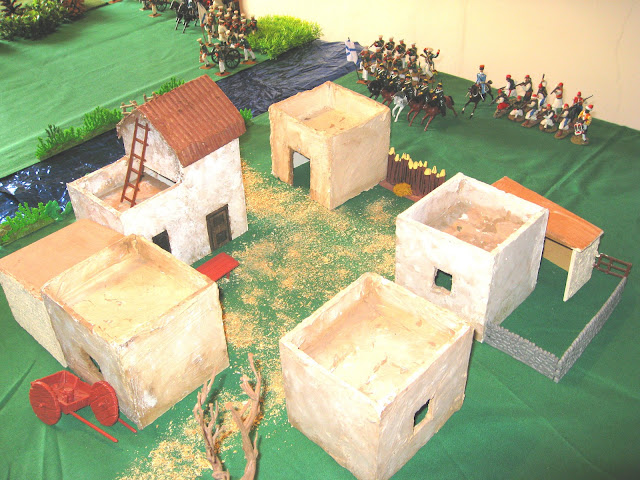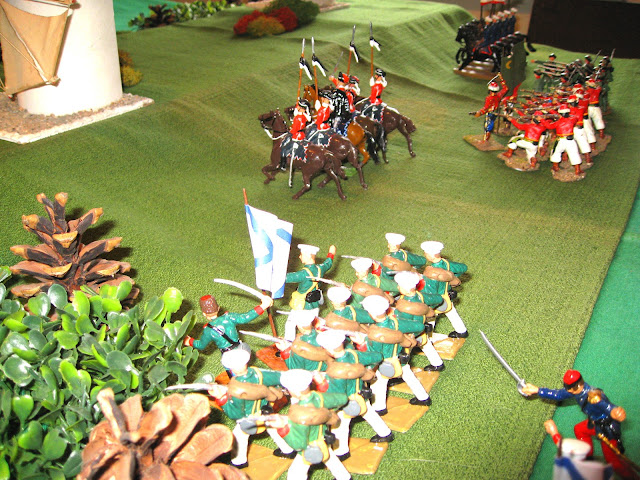I mentioned in an earlier post that I was attempting to compile a list of all 36 figures in the Oojah-Cum-Pivvy range produced between 1982 and 1984 by Shamus O D Wade, and here it is:
These are the O (Ooja-Cum-Pivvy) reference numbers I've identified in the order they are shown in the image above.
O.11 - O.6
- O.10 - O.9 - O.5 - O.12 - O.8 - O.4 - O.15
O.16 - O.34
- O.18 - O.1 – O.21 - O.2 – O.26 - O.30 – O.29 - O.3 - O.14 - O.7
O.22 - O.32
- O.35 - O.36 - O.33 - O.31 – O.19 – O.27 - O.25 - O.20 - O.13 - O.28 - O.24 - O.17
- O.23
O.1 Mexican
Infantry Alamo
O.2 Irish Kern
(1545)
O.3 Irish Galloglass (1522)
O.4 Soldier of the King of
Muli (1931)
O.5 Greek Light Infantry
(1813)
O.6 Etruscan Warrior
O.7 Kataphractos c. 1050
(Byzantine) -has a long removable spear
O.8 Basilikoi
Anthropoi c.880 (Byzantine)
O.9 Patzinak 11th
century (Byzantine)
O.10 Varangian Guardsman
c.1030 (Byzantine)
O.11 Hand Gonne
Man (Those who kept Faith at Bosworth Field, Aug 22, 1485)
O.12 Man at Arms
O.13 King
Richard III
O.14 Wounded
Archer
O.15 Mounted Archer, Fighting on Foot
O.16 Chief
Petty Officer (WRINS) 1945
O.17 Petty
Officer (WRINS) 1945
O.18 Leading
Auxiliary (WRINS) Naval HQ 1945
O.19 Auxiliary
Stripping Gun, Karachi Gunnery School 1945
O.20 Auxiliary
(WRINS) Naval HQ New Delhi 1945
O.21 Private
Tristan Da Chuna 1944
O.22 Regimental
Policeman, Pakistan Armoured Corps, 1983
O.23 Regimental
Policeman, Punjab Regiment, Pakistan,1983
O.24 Cadet
Southall Squadron Air Training Corps 1964
O.25
Chiswick Armed Association (1798-1802)
O.26 Flight
Sergeant Zahir-id-din Barber, Indian Air Force (IAF), Burma, 1944
O.27 Flying
Officer P J Chandran, Indian Air Force (IAF), Burma, 1944
O.28 Flight Lieutenant
Chopra, Indian Air Force (IAF), Burma, 1944
O.29 Aircraftsman
Matthews, Indian Air Force (IAF), Burma, 1944
O.30 Aircraftsman
Valiram Shauni, Indian Air Force (IAF), Burma, 1944
O.31 Junior
Commander D. Kapila, Women's Auxiliary Corps (India), 1944
O.32
Sergeant A. D'Silva, Women's Auxiliary Corps (India) 1944
O.33 Officer
Cadet (Indian), Women's Auxiliary Corps (India), 1945
O.34 Officer
Cadet (European), Women's Auxiliary Corps (India), 1945
O.35 Officer
Cadet (Anglo-Burmese), Women's Auxiliary Corps (India), 1945
O.36 Corporal,
Ceremonial Parade, Women's Auxiliary Corps (India), 1945
--------------------------------
Shamus was well known for his extensive, and perhaps rather esoteric, interest in military history so I expected his selection of subjects for the Oojah-Cum-Pivvy range to be diverse but I was surprised to find that 20th century Indian Armed Forces would comprise half the entire series.
In his Collectors Guide to New Toy Soldiers, Stuart Asquith tells us that the figures were sculpted by Graham Morris and manufactured for Shamus by Peter Cowan of Albion Miniatures, each figure was released singly in a limited edition of 100.
Having said that it does appear to me that the range does comprise a number of small sets:
O.7 to O.10 Byzantines, O.11 to O.15 Those who kept Faith at Bosworth Field, O.16 to O.20 Women's Royal Indian Navy, O.26 to O.30 Indian Air Force and O.31 to O.36 Women's Auxiliary Corps (India)
The five "Indian Air Force" figures (numbers O.26 to O.30) were based on a famous Second World War photograph of a Vultee A-31 Vengeance Crew from No.8 Squadron. The photograph (reproduced below from "The Eagle Strikes" shows Flt Lt Haveli Shah Chopra (one of the RAF 24) and his Gunner Fg Offr P J Chandran leaning against an A-31 Vengeance dive bomber, flanked by the three airmen/ground crew Zahir-ud-din Barber, Mathews and Veliram Shauni.



























































